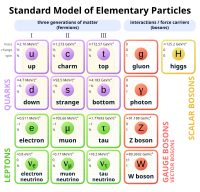
Photo from wikipedia
We investigate hybrid structures based on a bilayer quantum spin Hall system in proximity to an s-wave superconductor as a platform to mimic time-reversal symmetric topological superconductors. In this bilayer… Click to show full abstract
We investigate hybrid structures based on a bilayer quantum spin Hall system in proximity to an s-wave superconductor as a platform to mimic time-reversal symmetric topological superconductors. In this bilayer setup, the induced pairing can be of intra- or inter-layer type, and domain walls of those different types of pairing potentials host Kramers partners (time-reversal conjugate pairs) of Majorana bound states. Interestingly, we discover that such topological interfaces providing Majorana bound states can also be achieved in an otherwise homogeneous system by a spatially dependent inter-layer gate voltage. This gate voltage causes the relative electron densities of the two layers to vary accordingly which suppresses the inter-layer pairing in regions with strong gate voltage. We identify particular transport signatures (zero-bias anomalies) in a five-terminal setup that are uniquely related to the presence of Kramers pairs of Majorana bound states.
Journal Title: Physical Review B
Year Published: 2019
Link to full text (if available)
Share on Social Media: Sign Up to like & get
recommendations!